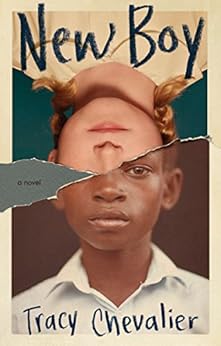3 Stars
Osei Kokote
is a Ghanaian diplomat’s son. He arrives
at an all-white school to attend the last month of Grade 6. The smart, popular, all-American girl, Dee Benedetti,
is assigned to help him through his first day.
A mutual attraction is evident from the beginning, though Dee’s best friend
Mimi advises caution. Mimi’s boyfriend
Ian also looks askance at Dee’s relationship with a black boy who also
threatens his position as king of the schoolyard: “Ian would always notice anyone new who
stepped into his territory. For the playground
was his. It had been all year, since he
had started sixth grade and there were no older boys to rule it. He’s had months to relish this
domination. Any new boy posed a
challenge. And this new boy, well . . . ”
Ian uses his sidekick Rod to make Osei suspect Dee is attracted to
Casper, the popular boy in the school, even though Casper is involved with
Blanca.
Chevalier’s
version parallels Shakespeare’s play quite closely. The names of the characters clearly suggest
their counterparts in the latter. Besides
Osei (Othello), Dee (Desdemona), Ian (Iago), Mimi (Emilia), Rod (Roderigo),
Casper (Cassio), Blanca (Bianca), the teacher who distrusts Osei is Mr. Brabant
(Brabantio), and the principal is Mrs. Duke.
The handkerchief with embroidered strawberries from Othello’s mother has
become a pencil case embossed with strawberries belonging to Osei’s beloved
sister. There are some nice
touches: apparently “Osei” means noble, a trait emphasized in
Othello. When Osei becomes less rational,
Chevalier even includes some animal imagery to describe him, just like
Shakespeare does: “he looked like a wolf
growling.” Love changes Desdemona such
that she disobeys her father Brabantio; Dee also becomes a bit of a rebel and
stands up to Mr. Brabant even though he is “the teacher you impressed if you
could – the way she felt about her own father.” Ian’s last words (“Nothing. I have nothing more to say”) copy Iago’s “Demand
me nothing. What you know, you know./ From
this time forth I never will speak word.”
Though
clever in its parallels, this retelling does not always work. The main characters are in Grade 6 and
between 11 and 12 years of age, but they seem very sexualized. They engage in French kissing and sexual
touching, “make out” in corners of the playground, and speak about “going all
the way”. I understand schoolyard drama
with its ever-shifting allegiances and ever-changing crushes, but pre-teens 40
years ago were less sexually aware than modern tweens. (I couldn’t help but think that Chevalier was
thinking of Shakespeare’s Juliet who is 11 years old.) The children in the
novel are also inconsistent; at times they behave childishly and play childish
games but at other times make mature, insightful observations and are very
self-aware. I think high school students
as main characters would have been more appropriate.
Another
issue I had is the duration of the story.
I understand that Chevalier was following Aristotle’s unities of action,
place and time (a single action represented as occurring in a single place and
within the course of a day), but she could have dispensed with this theatrical
convention since she was writing a novel.
Dividing the story into five parts of the school day spent in a school
yard (before classes, morning recess, lunch, afternoon recess, after classes)
is a nice nod to the five acts of the tragedy but is not really necessary. The events occur in about 8 hours at most.
A strength
of the novel is its examination of racism.
It is emphasized much more in the novel.
The treatment Osei receives from classmates and teachers is very much
caused by racism: “In some ways overt
racism based on ignorance was easier to deal with. It was the more subtle digs
that got to him.” There is no doubt that
the racism “a bl – a new boy” encounters is realistic.
The
character of the villain is problematic.
In the play, Othello believes Iago because he has made himself seem very
trustworthy. His behaviour seems exemplary so it’s plausible
that Othello fall for Iago’s manipulations.
Ian’s behaviour, on the other hand, is not exemplary; he is a bully whom
everyone, even the teachers, fears and no one trusts. There has not been sufficient time for Ian to
prove himself trustworthy. Osei even
sees Ian bullying the younger students.
Why then would Osei trust him and believe him so easily? He so easily distrusts Casper whom everyone
seems to like, but he doesn’t question the motives of the boy who is disliked
by virtually everyone? Osei seems exceptionally
even-tempered but then rapidly changes into someone quick to anger, and that
character change is not believable either.
The book is
a quick, undemanding read. It adapts
some elements of the tragedy in an interesting way. Unfortunately, the use of pre-teens as main
characters and the adherence to the unity of time do not work
convincingly. The novel lacks depth; I
found myself reading only to see how the author would adapt the ending of Othello.
Note: I received an eARC of the book from the publisher via NetGalley.

No comments:
Post a Comment